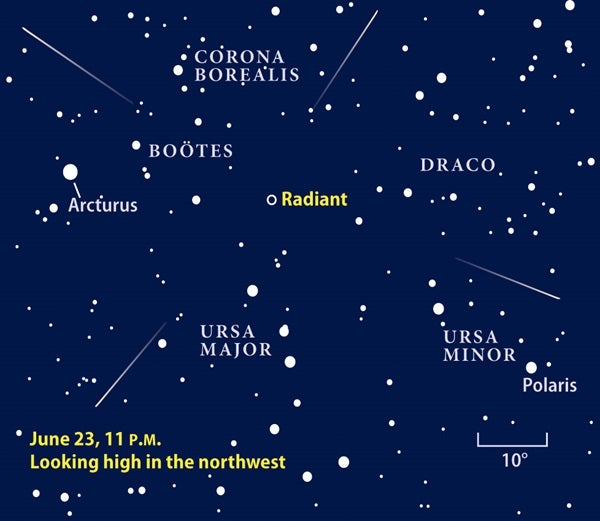The northern constellation Boötes the Herdsman is easy to find because the brilliant orange star Arcturus marks its base. Arcturus ranks fourth-brightest of all nighttime stars. To find it, first find the Big Dipper, and follow the curve of the Dipper’s handle away from the Dipper to dazzling Arcturus.
The radiant — the point in the sky where the meteors seem to come from — lies about 30° (one-sixth of the way across the sky) north-northeast of Arcturus. The Boötids’ radiant is high in the northern sky early in the evening and high in the northwest at midnight. Unfortunately, the highest hourly rates occur a few hours before dawn, but bright moonlight will obscure all but the brightest streaks. The predawn hours offer the best viewing because that’s when your location will face Earth’s direction of travel. In essence, Earth will be running into the meteors.
The Boötids shower usually is a weak one, with rates around 10 meteors per hour, but it has been strong at times. One such outburst happened June 27, 1998. Skywatchers observed hundreds of meteors streaming out of Boötes over a few-hour period. Earth had encountered a denser part of the meteoroid stream. The years 1916, 1921, and 1927 also saw meteor activity way above normal. More recently, another nice display occurred in 2004.
Because the Boötids’ parent comet, 7P/Pons-Winnecke, has a 6-year period, and because observers noted an up-tick in activity during 1998 and 2004, the shower could shine again in 2010.
The International Meteor Organization also predicts a possible increase in activity this year. Astronomers in that group suggest higher rates due to debris Pons-Winnecke laid down in the 19th century. The spike should occur the night of June 23, likely between 7 p.m. and midnight EDT.
It’s best to view meteor showers without optical aid, using just your eyes so as not to restrict the field of view. For the Boötids, face generally northward and look about halfway up. Glancing around won’t hurt your chances of seeing meteors.
Astronomy magazine Contributing Editor Raymond Shubinski advises, “Meteor showers are great social and family events. Organize your own group of skygazers and head out of town to a dark location. Take lawn chairs, snacks, and cold drinks. Make it a party!”
- Most visible meteors lie within 120 miles (200 kilometers) of an observer.
- Meteors become visible at an average height of 55 miles (90 km). Nearly all burn up before they reach an altitude of 50 miles (80 km).
- No known meteorite has been associated with a meteor shower. (That is, no shower meteor has ever survived its flight through the atmosphere and been recovered.)
- The typical bright meteor is produced by a particle with a mass less than 1 gram and with a size no larger than a pea.
- The average total mass of meteoritic material entering the Earth’s atmosphere is estimated to be between 100 and 1,000 tons (91,000 and 910,000 kilograms) per day.
- The hourly rate on a “non-shower” night is approximately 6 meteors per hour.
- A meteoroid enters the atmosphere at velocities between 25,000 and 165,000 mph (40,300 and 265,000 km/h).
- Observing podcast: The Boötid meteor shower, the double star Graffias, and Seyfert’s Sextet
- Video: How to observe meteor showers
- StarDome: Locate the Boötids meteor shower’s radiant in your night sky with our interactive star chart.
- Sign up for our free weekly e-mail newsletter.











